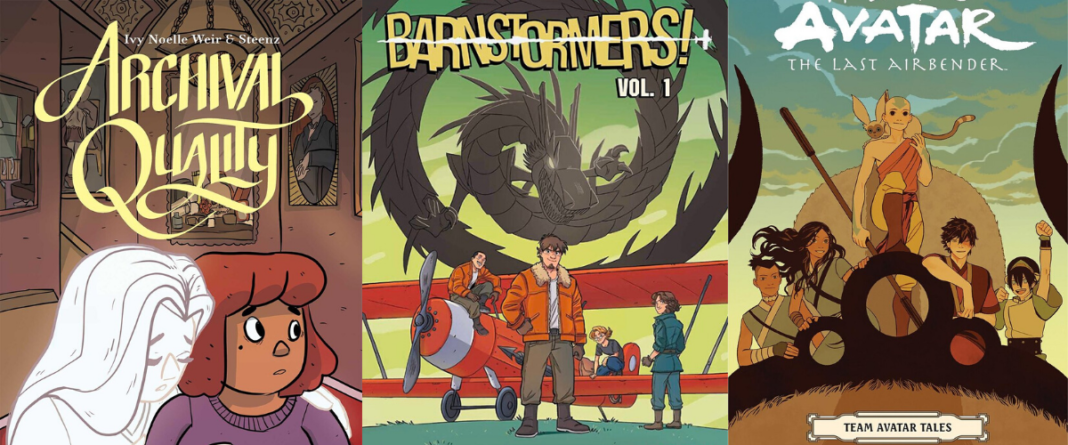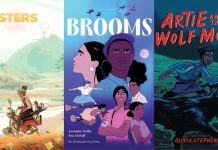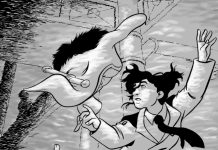Given the last decade’s definitive trend toward YA graphic novels and kids’ comics, what does the future of comics look like? C2E2’s “The New Comics Generation” panel addressed just that. On hand for the discussion were panelists Christina “Steenz” Stewart (Archival Quality), Dave Scheidt (Mayor Good Boy) and Kenny Porter (Barnstormers).
Following a preamble of chatting about Furbies and their inherent creepiness, the creators introduced themselves and got right down to discussion, framed with questions and prompts from Porter.
What was it like growing up reading comics?
Steenz and Scheidt agreed that newspaper strips were huge for them, even though they weren’t necessarily geared towards kids. Friends were huge Dilbert fans, in spite of that character’s inherent adult problems. But, those strips were all that was available at the time.
On that note, Scheidt admitted he also read out of his expected age range, falling in love with horror novels, Batman Adventures, and the animated series as well as Hellboy.
That’s juxtaposed with kids today who, Steenz added, can head to gocomics.com and read as much as they want, whenever they want, for free, so long as they have internet access. But, that’s what kids have now. When she and Schiedt were growing up, they were restricted by what their parents or guardians had lying around. She remembered obsessively reading Reader’s Digest mysteries, because it was what her Grandma had, and still loves those stories today.
Porter, meanwhile, grew up on Richie Rich, Casper the Friendly Ghost and various Star Trek media. But he transitioned quickly to his next question, bouncing off of Steenz’ point.
Where did you get your comics?
As mentioned, comics were more difficult to come by until recently. That’s why, Steenz said, in the ghettos of Detroit she saw them most frequently in the hospital, where a spinner rack of Archie comics sat. It wasn’t until later that she realized actual, dedicated comic shops existed, although she, too watched the Batman: The Animated Series.
Porter hopped in here, noting that now, the opposite is true. BOOM! is putting their comics in the grocery displays where he’s from, stocking big sellers like Dogman. Scheidt was quick to agree there, going on a tangent about loving that he can pick up tater tots and a comic he wrote all in one Target run.
What caused the surge in kids’ comics that’s creating the new comics generation?
Panelists remembered comics being confiscated in school because there was such a stigmatization around them. Scheidt noted that in many classrooms, the opposite is now true; teachers are using them as a reward and even using them as tools for education. All that was to say that those teachers, he presumes, are probably those same kids whose comics were taken from them. The nerds are in power now, and he suspects that’s part of the reason for the surge.
Steenz, who teaches 4th graders, said that it’s got to do with internet and phones. All of her students read Webtoons, and when she speaks at colleges attendees immediately perk up when they hear she edits at Tapas. It’s all about accessibility.
The conversation turned to libraries and library services like Hoopla from there, as all three panelists talked about how borrowing comics through those services benefit creators, even if you’re not paying for them. Hoopla in particular even stays up to date on single issues, meaning anyone with a library card can read the Big Two, or even ongoing favorites. Steenz said she was able to read the entire first arc of Something is Killing the Children thanks to a late night Hoopla browse.
So much of what kids are reading is graphic novels and full volumes. How will serialized comics be affected?
Steenz was the first to notice floppies’ fragility. Parents want bang for their buck, and $4 for twenty pages of comic, plus ads, doesn’t cut it the way a graphic novel does. There are great parts of waiting for single issues and being part of the community, but kids are getting that from platforms like Webtoon and Tapas already.
The Shonen Jump model was brought up by Porter, wondering if a collected magazine might be more enticing for buyers. Scheidt said that’s already happening in some indie corners, with zines and anthologies becoming more and more popular.
But, Porter added that the Big Two are finally coming around as well. Steenz highly recommended the recent graphic novel Shadow of the Batgirl, with the stipulation that, since it’s the beginning of a movement, there isn’t much of this character for future reading. Yes, she exists in Batgirl, but it’s really only the same character in name.
Porter said he hopes this changes as the line buffs up, especially in the case of the recent Green Lantern: Legacy, considering this is the character’s only appearance. Kids are immediately asking what comes next and DC can’t put stories on the shelves quick enough.
If the new comics generation is reading from a younger age, how will that affect what they look for later on in terms of complication with layouts and genres?
The panel agreed here that starting with the straightforward structures geared towards them will only push kids’ comic reading abilities later on. They’ll be able to read stories so complex that we probably can’t even think of what they are right now. This time is setting the stage for readers for the rest of their lives. Porter had the last word, hoping the books these kids ask for are super weird, before opening the conversation up to topics of the panelists’ choosing.
Any other topics?
Thinking about C2E2, Scheidt had nothing but good things to say about the con. He loves how diverse the Artists’ Alley is here and is constantly seeing more people putting out zines and minicomics. That’s exactly what a kid needs to see to be inspired themselves; something raw that doesn’t need to have a publisher’s logo to exist. He’s seen it happen himself. For the last few years, a particular young fan of his has consistently shown up to his table with his parents and a copy of his latest comic. He says it’s hugely important for creators to encourage kids like this.
Porter agreed, saying that tablets and kids’ accessibility to new art tools will make for some awesome comics. The topic swiveled to library cons, a favorite of Steenz’. She said creators are more than happy to make free appearances and spend time with young readers to continue developing their love of comics.
From there, the formal portion of “The New Comics Generation” ended, transitioning into audience Q&A. The first of which is: what makes a kids’ comic a kids’ comic? Steenz was quick to say that it’s not about content. It’s about how it’s packaged. The questioner asked specifically about gentrification as a theme in their own story, so Steenz assured them that readers will understand as long as it’s delivered clearly. Be real and be straightforward, she said.
Next, Porter, Steenz and Scheidt gave tips on how to keep a Webtoon comic going. An editor over at Tapas, Steens was first to say that you should never be in a ‘figure it out as you go’ position. The first thing a creator should do is to have a full outline and figure out how to break it up in a satisfying way. Scheidt jumped in, adding that no one should be afraid to end a story. It’s an amazing feeling and you always learn something new. Try small projects and build from those.
Porter took that and ran, urging the questioner to be ready to end a story at a moment’s notice. As soon as your characters stop changing, your story stops with it. He joked that going to school for writing only taught him how to get a grade, not how to finish something.
With that, “The New Comics Generation” wrapped.







